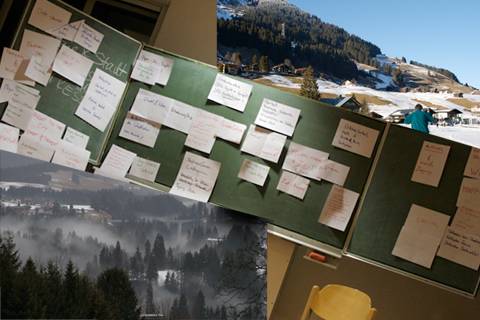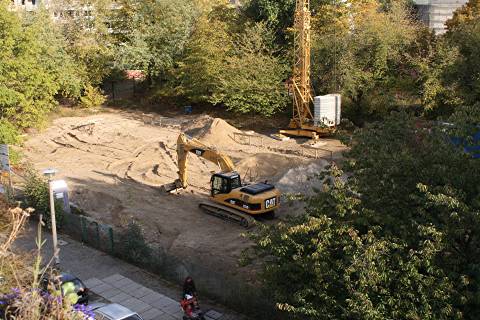Hier ein neuer Call for Papers, dieses Mal für eine über das Nachwuchsnetzwerk Stadt-Raum-Architektur organisierte kleine, feine Tagung, bei der ich im Organisationsteam mit dabei bin:
Deadline für Einsendungen: 1. Juli 2013
Jenseits von Stadtland/Diesseits des Dualismus von Stadt und Land
Positionen zeitgenössischer Sozialforschung zum Bauen und Leben im ländlichen Raum Tagung des Nachwuchsnetzwerks Stadt – Raum – Architektur in Bezau, Vorarlberg (Bregenzerwald) 4./5. Oktober 2013
Die Stadt und das Städtische sind Ziel, Bühne und Verhandlungsort moderner „Kultur“, seit dieser Begriff von seiner ursprünglich agrarischen Bedeutung als „Landbau“ abgelöst wurde. Mit dem Übergang zur Neuzeit werden Begriffe wie Kultur und Kultiviertheit den Erzeugnissen der Kunst aller Gattungen zugesprochen, via Referenzierung Sprache, Geist, Bildung und dem Habitus der Gebildeten einverleibt und seither von Akademien verwaltet.
Das Land und das Ländliche erhalten in diesem Vorgang ihre Rolle als Gegenmodell, welches seine Plausibilität jedoch nur in Abgrenzung vom Städtischen und dessen modernen Konnotationen gewinnt. Das Ursprüngliche, Eigentliche und Urwüchsige, das Unverbildete, welches dem und den Ländlichen zugeschrieben wird, in ihm und ihnen gesucht, gefunden, geschützt und bedichtet wird, hat nicht nur Pflegeformen städtischer Kultur im ländlichen Milieu, wie die „Kunst des Landlebens“ (Frühsorge 1993), sondern auch eine meist implizit bleibende Spaltung der wissenschaftlichen Befassung mit Gesellschaft hervorgebracht: jene in die Volkskunde (als „Bauernkunde“) zur Erforschung ländlicher und die Soziologie zur Erforschung städtischer Gesellschaften (von „Arbeiterkultur“ bis zu Eliten).
Spätestens seit dem Spatial turn in der Soziologie und der Hinwendung zum Alltag anstelle eines Raumes in der Volkskunde sind solch tradierte Territorialgrenzen der jeweiligen Gegenstandsverortungen durchlässiger geworden. Seither überwiegen in beiden Fächern die Auseinandersetzungen mit städtischen gegenüber ländlichen Phänomenen. Erst die breite Übernahme einer globalisierungskritischen Haltung in den Habitus akademischer Eliten hat im letzten Jahrzehnt auch den sozial- und kulturwissenschaftlichen Blick wieder verstärkt auf ländliche Gesellschaften gerichtet. Speziell deren traditionelle, von Kleinräumigkeit, Subsistenz und Gemeinschaftseigentum geprägte und als Widerständigkeit gedeutete Praxen dienen nun (erneut) als Argumente gegen einen als hegemonial empfundenen Anspruch neoliberaler Wirtschafts- und Entwicklungspolitik.
Darauf aufbauend, wollen wir unser Treffen dazu nutzen, „das Ländliche“, seine Akteure, Gesellschaften und Räume, wie sie sich in aktuellen Forschungsansätzen spiegeln, neu auszuleuchten und zu diskutieren.
Mögliche Themen zur gemeinsamen Bearbeitung sind:
- Die aktuelle Ökonomisierung und Ästhetisierung des ländlichen Raumes, Landschaft als Bild, als Park, als Museum
- Das Spannungsfeld zwischen traditionell-ländlicher Autonomie mit kleinräumigen Verwaltungsstrukturen einerseits und transnationalen Wirtschaftsinteressen andererseits.
- Regionalität als Kategorie/Technik von Governance
- Aspekte und Schauplätze von Re-Ruralization, Schrumpfung, Brachlegung und Abwesenheit
- Zersiedlungsdebatten, Steuerung/Steuerbarkeit von Siedlungsstrukturen
- Landleben zwischen suburbanem Wohnen und global village
- Die technisch-informative Durchdringung des ländlichen Raumes und neue Bezüge, die sich darüber herstellen
- Das Spannungsfeld zwischen engen, ortsgebundenen Netzwerken und zunehmender Mobilität. Ländliche Gemeinschaft vs. ländliche Enge
- Die spezifische Räumlichkeit sozialer Praktiken, z.B. im Hinblick auf mehr und weniger „verdichtete“ Räume
- Zeitgemäße Beschreibungen, Rollenzuweisungen und Umdeutungen traditioneller ländlicher Wirtschafts- und Produktionsformen in Handwerk und Landwirtschaft, z.B. im Hinblick auf ihre gegenwärtige „Pädagogisierung“.
- Die explizite Diskussion des Stadt-Land-Gegensatzes und seiner Grenzen
Andere Themenvorschläge sind willkommen. Das Treffen soll in offener Atmosphäre nicht nur die Diskussion von Ideen ermöglichen, sondern auch die Entwicklung weitergehender und fächerübergreifender Zusammenarbeit fördern.
Als Tagungsort steht uns, passend zum Thema, ein ländliches Berghotel in 1.220 m Seehöhe zur Verfügung. Wegen der begrenzten Bettenzahl bitten wir auch nichtvortragende Teilnehmer um frühzeitige Anmeldung. Wir empfehlen eine Anreise am 3. Oktober. Die Kosten für zwei Übernachtungen inkl. Bewirtung betragen etwa Eur 120.- pro Person.
Wir freuen uns über Abstracts mit einer Länge von maximal 500 Wörtern, die bis zum 1. Juli 2013 an unsere Kontaktadresse gesandt werden. Bis zum 5. August erhalten Sie von uns eine Rückmeldung.
Organisation:
Stephanie Kernich (Zürich), Wiebke Reinert (Marburg), Lars Frers (Telemark), Günther Prechter (Bregenz)
Kontakt:
Der Call als PDF-Dokument: CfP-Jenseits-von-Stadtland.pdf
 Der Strategieworkshop der Darmstädter Stadtforschung im Kleinwalsertal war inhaltlich und dynamisch ein voller Erfolg – Stadtforscher der Republik: haltet die Augen und Ohren auf und bereitet Euch innerlich auf das vor, was da so kommen wird…!
Der Strategieworkshop der Darmstädter Stadtforschung im Kleinwalsertal war inhaltlich und dynamisch ein voller Erfolg – Stadtforscher der Republik: haltet die Augen und Ohren auf und bereitet Euch innerlich auf das vor, was da so kommen wird…! Mit einem Seufzer im Herzen habe ich heute noch mal ein Bild von der früheren Brache auf dem Gelände Choriner Straße 32a gegenüber von unserem Balkon gemacht. Vor kurzem hat Olli da noch in der Sonne gesessen und meine Dissertation Korrektur gelesen. Aber nun wird die verführend verfallende Fläche von der Härte des Immobiliengeschäfts ereilt. Ich habe bisher noch keine Tafel erspäht, die ankündigen würde was auf dem ehemaligen Gelände der KiTa eigentlich gebaut wird. Eine große Erleichterung ist nur, dass der wundervolle Kirschbaum (im Bild unten rechts) anscheinend erhalten bleibt. Es wäre wirklich grausam gewesen, wenn der hätte fallen müssen…
Mit einem Seufzer im Herzen habe ich heute noch mal ein Bild von der früheren Brache auf dem Gelände Choriner Straße 32a gegenüber von unserem Balkon gemacht. Vor kurzem hat Olli da noch in der Sonne gesessen und meine Dissertation Korrektur gelesen. Aber nun wird die verführend verfallende Fläche von der Härte des Immobiliengeschäfts ereilt. Ich habe bisher noch keine Tafel erspäht, die ankündigen würde was auf dem ehemaligen Gelände der KiTa eigentlich gebaut wird. Eine große Erleichterung ist nur, dass der wundervolle Kirschbaum (im Bild unten rechts) anscheinend erhalten bleibt. Es wäre wirklich grausam gewesen, wenn der hätte fallen müssen…